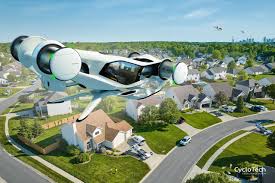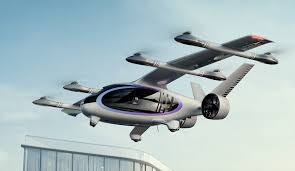
EVTOL AIR CAR
INTRODUCTION:

Electric Vertical Take-Off and Landing (eVTOL) aircraft represent a transformative shift in aviation technology. They promise to revolutionize urban mobility, reduce traffic congestion, and mitigate environmental impacts associated with traditional aviation.
These innovative aircraft are designed to combine the efficiency of electric propulsion with the versatility of vertical takeoff and landing capabilities, enabling them to operate in urban environments where space is limited and traditional runways are impractical.
HOW EVTOL AIR CARS WORK?
Electric propulsion
At the core of eVTOL technology is electric propulsion, which relies on electric motors powered by batteries or other electric power sources. This contrasts with traditional aircraft that use internal combustion engines. Electric motors offer several advantages, including lower noise levels, reduced emissions, and greater efficiency. The electric powertrain of an eVTOL typically consists of a battery pack, electric motors, and power electronics that manage energy distribution.
Vertical takeoff and landing
eVTOL aircraft are designed to take off and land vertically, similar to helicopters. This capability is achieved through various rotors, ducted fans, or tiltrotor configurations. The vertical lift is typically provided by multiple rotors distributed around the aircraft, which can be tilted or adjusted to transition from vertical to horizontal flight. During takeoff and landing, the rotors are positioned to provide vertical thrust, while in cruise flight, they can be tilted to generate forward thrust and lift.
Autonomous and piloted operation
Many EVTOL designs incorporate advanced avionics and autonomous flight systems to enhance safety and operational efficiency. Autonomous flight technology allows these aircraft to operate with minimal human intervention, reducing the potential for human error. However, some EVTOLs are also designed to be piloted remotely or by an onboard pilot, providing flexibility in operation and ensuring compliance with existing aviation regulations.
TYPES OF EVTOL CARS:
The eVTOL market is diverse, with numerous designs and configurations tailored to specific use cases and operational environments. These designs can be broadly categorized into the following types:
- Multirotor eVTOLS
- Lift + Cruise eVTOLS
- Tiltrotor and Tiltwing eVTOLs
- Vectored Thrust eVTOLs
ADVANTAGES OF EVTOL CARS:
- Reduced Traffic Congestion: eVTOLs can bypass road traffic by flying above it, reducing congestion in urban areas and providing a faster, more efficient means of travel. This could drastically decrease commute times and improve the flow of transportation.
- Environmentally Friendly: Since eVTOLs are electric-powered, they produce zero emissions, making them a more sustainable option compared to traditional gas-powered vehicles. This helps reduce the carbon footprint and contributes to cleaner air in cities.
DISADVANTAGES:
Regulatory and Safety Challenges: eVTOLs would require extensive regulatory frameworks and safety protocols. Ensuring air traffic control, developing airspace management systems, and addressing issues like crash prevention, maintenance standards, and pilot training would be complex and time-consuming.
Battery Limitations and Range: Although electric-powered, current battery technology limits the range and flight duration of eVTOLs. This could make long-distance travel impractical, and frequent recharging or battery swapping might be necessary, potentially limiting their utility and increasing operational costs.
THE FUTURE OF EVTOL CARS:
Urban air mobility (UAM) networks
Establishing urban air mobility networks (UAM networks) is a critical step in realizing the full potential of EVTOL aircraft. The advent of electric vehicles created a demand for an electric charging infrastructure. Due to their very nature, EVTOL electric aircraft require a unique infrastructure, namely their own operating facilities. Vertiports are airports specifically designed to support the operation of EVTOL aircraft. They will include:
- Essential elements such as multiple landing and takeoff pads for vertical operations
- Passenger terminals for check-in and boarding
- Charging and refueling stations for battery-electric and hydrogen-powered EVTOLs
- Maintenance and repair facilities for routine inspections and servicing.
Additionally, vertiports are integrated with advanced air traffic management systems to ensure safe and efficient airspace coordination, and they include control centers to oversee ground and flight operations.
Advancements in battery technology
Battery technology is critical to the performance and viability of eVTOL aircraft. Advances in energy density, charging speed, and battery lifespan will enhance the range, payload capacity, and operational efficiency of eVTOLs. Research and development in solid-state batteries, fast-charging systems, and energy management will play a crucial role in the future of eVTOL technology.
Autonomous flight and AI integration
Integrating autonomous flight systems and artificial intelligence (AI) will significantly impact the eVTOL industry. Autonomous flight technology can improve safety, reduce operational costs, and enable more efficient use of airspace. AI can assist in route optimization, predictive maintenance, and real-time decision-making, enhancing the overall performance and reliability of eVTOL operations.
Environmental impact and sustainability
eVTOL aircraft have the potential to reduce the environmental impact of urban transportation by decreasing reliance on fossil fuels and reducing traffic congestion. Using electric propulsion results in lower emissions and noise levels than traditional aircraft. As the industry grows, there will be a focus on sustainable practices, including using renewable energy sources and eco-friendly materials.
Regulatory framework and public acceptance
The successful deployment of eVTOL aircraft will require a supportive regulatory framework and public acceptance. Regulatory agencies are working on developing standards and guidelines for the certification and operation of eVTOLs. Public acceptance will depend on demonstrating the safety, reliability, and benefits of eVTOL technology. Community engagement and transparent communication will be essential in building trust and addressing noise, privacy, and safety concerns.

